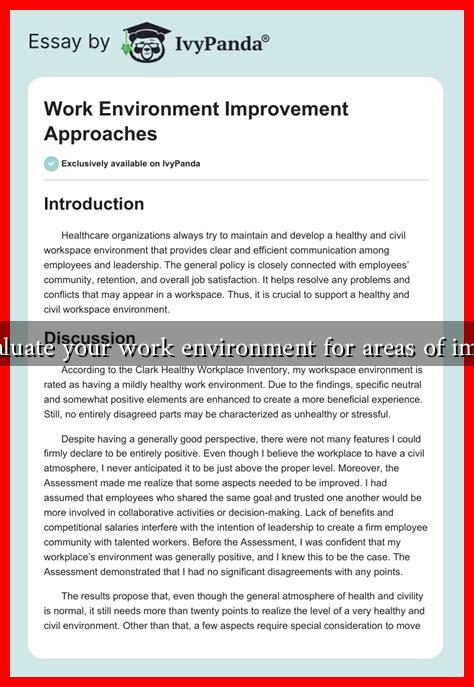-
Table of Contents
- How to Evaluate Your Work Environment for Areas of Improvement
- Understanding the Importance of a Positive Work Environment
- Key Areas to Evaluate
- Steps to Conduct an Evaluation
- 1. Gather Employee Feedback
- 2. Observe Workplace Dynamics
- 3. Analyze Performance Metrics
- 4. Benchmark Against Industry Standards
- Implementing Changes for Improvement
- Conclusion
How to Evaluate Your Work Environment for Areas of Improvement
In today’s fast-paced and ever-evolving workplace, evaluating your work environment is crucial for fostering productivity, employee satisfaction, and overall organizational success. A well-structured evaluation can help identify areas that need improvement, leading to a more efficient and harmonious workplace. This article will guide you through the process of assessing your work environment and suggest actionable steps for enhancement.
Understanding the Importance of a Positive Work Environment
A positive work environment is not just a luxury; it is a necessity for any organization aiming for success. According to a study by Gallup, organizations with engaged employees outperform those without by 202%. This statistic underscores the importance of creating a workplace where employees feel valued, motivated, and productive.
Key Areas to Evaluate
When assessing your work environment, consider the following key areas:
- Physical Space: Evaluate the layout, cleanliness, and comfort of your workspace. Is it conducive to collaboration and productivity?
- Company Culture: Analyze the values, beliefs, and behaviors that shape your workplace. Is there a culture of respect and inclusivity?
- Communication: Assess how information flows within the organization. Are employees encouraged to share ideas and feedback?
- Work-Life Balance: Consider whether employees have the flexibility to manage their personal and professional lives effectively.
- Employee Development: Evaluate the opportunities for training and growth. Are employees given the resources they need to advance their skills?
Steps to Conduct an Evaluation
To effectively evaluate your work environment, follow these steps:
1. Gather Employee Feedback
One of the most effective ways to assess your work environment is to solicit feedback from employees. This can be done through:
- Anonymous surveys
- Focus groups
- One-on-one interviews
For instance, a company like Google regularly conducts employee surveys to gauge satisfaction and gather suggestions for improvement. This practice not only helps identify issues but also fosters a sense of belonging among employees.
2. Observe Workplace Dynamics
Take time to observe how employees interact with one another and their workspaces. Look for signs of collaboration, engagement, and morale. Are employees communicating openly? Are they collaborating effectively? Observations can provide valuable insights that surveys may not capture.
3. Analyze Performance Metrics
Review performance metrics such as productivity rates, employee turnover, and absenteeism. High turnover rates may indicate dissatisfaction with the work environment. According to the Society for Human Resource Management (SHRM), organizations with high employee engagement have 25% lower turnover rates.
4. Benchmark Against Industry Standards
Compare your work environment with industry standards. Research best practices and trends in your sector to identify areas where your organization may be lagging. Resources like Gallup and SHRM provide valuable insights into workplace trends and benchmarks.
Implementing Changes for Improvement
Once you have identified areas for improvement, it’s time to take action. Here are some strategies to consider:
- Enhance Communication: Implement regular team meetings and open-door policies to encourage dialogue.
- Invest in Employee Development: Provide training programs and mentorship opportunities to help employees grow.
- Redesign Workspaces: Create collaborative spaces and ensure that work areas are comfortable and well-equipped.
- Promote Work-Life Balance: Offer flexible working hours and remote work options to support employees’ personal needs.
Conclusion
Evaluating your work environment is an essential step toward creating a more productive and satisfying workplace. By focusing on key areas such as physical space, company culture, communication, work-life balance, and employee development, organizations can identify areas for improvement. Gathering employee feedback, observing workplace dynamics, analyzing performance metrics, and benchmarking against industry standards are effective methods for conducting a thorough evaluation. Implementing changes based on these insights can lead to a more engaged workforce and ultimately drive organizational success.
In summary, a proactive approach to evaluating and improving your work environment can yield significant benefits, including increased employee satisfaction, reduced turnover, and enhanced productivity. Take the time to assess your workplace today, and pave the way for a brighter future.

